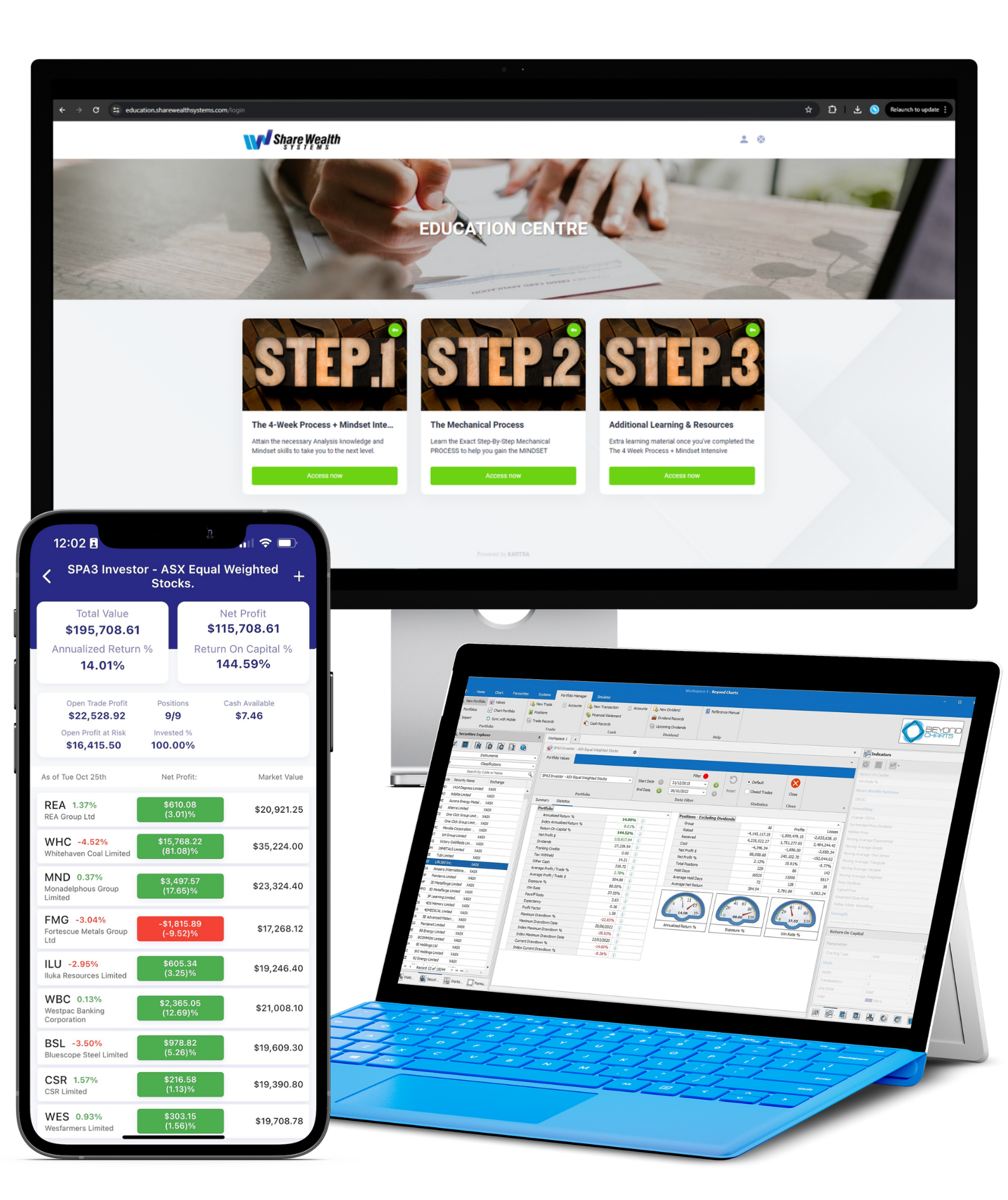
And how to go about it
Too many investors fail because they let noise and randomness influence or control their investment decisions. Something they’d never allow if they were running a business.
Because successful businesses implement successful processes. And have plans & strategies for every possible scenario they may encounter.
In a profitable business, systems are set up to maximize efficiency and ensure an optimal use of resources.
Profit goals are clearly defined, along with benchmarks and KPIs to measure how successful the business is in achieving them. Procedures are standardized and systems are in place to guide everyone’s actions through clear roles and responsibilities. This in turn reduces human error to a minimum…
And ensures chaos and randomness can never creep into day-to-day operations.

As a self-directed investor, you should and can have a similar process in place to guide your investing. But setting up and maintaining such a process doesn’t have to be nearly as complicated as it is for most businesses.
All you need is a detailed Investment Plan, which includes an investing system with a verified Edge, comprised of clearly defined timing criteria to help you execute that Plan without exception.
I’ll talk more about why having a verified investing system is a must if you want to run your investing like a business later. For now, I want to focus on helping you create an efficient business-like process for your investing.
Let’s dig into it.
7 Steps You Must Go Through To Create An Efficient “Business Process” That Guides Your Investing Efforts

Successful business owners and successful investors both routinely go through the following steps. It takes some thought and time investment to set them up initially…
But once you bridge that initial effort, it’s all about refining to perfection.
Before I walk you through the steps, let me issue this warning:
The following 7 steps are far from revolutionary. In fact, most would say they are plain boring.
Hence, nary a few people actually go through them. Which is one of the main reasons they fail both in business and investing.
Running after shiny new objects and fads might be more exciting. But if you want to set yourself up for success, you must do the background prep work others ignore. Because while it might be boring and unsexy — it’s crucial for success.
If you’re ready to do the work, go through the 7-step process below and start applying it to your investing instantly.
Step 1: Define Your Investing Goals
Before you start creating and implementing your investing process, you must figure out why you’re creating it in the first place.
In other words, what do you want to accomplish with your investing efforts in the long term? And how and why can this process help you get there.
Of course, just setting goals is far from enough. You also must define how you’ll achieve them and measure if you’re on the right path…
And break that “success control” into both short and long-term applicable criteria.
Step 2: Plan And Map Your Process
Be as detailed and specific as possible when doing this.
What strategies will you need to adopt to achieve your goals?
Where will you find such strategies?
How will you adapt them based on changing market circumstances?
Step 3: Set Concrete Actions And Define Who Should Complete Them
Even if you’re handling investing all on your own, you’re bound to have machines and computers on your side.
Make sure to identify which tasks are up to them and what you (and maybe an eventual team) will handle. Having a well-defined decision support system for every possible scenario helps prevent emotions and uncertainty from affecting your decisions in the heat of the moment.
Instead, you revert to the pre-defined script of the system and follow it to the letter.
Plan for every possible scenario and change the market may bring. Then you can simply consult your plan and know how to act in both up and down periods.
And make sure you write your Investment Plan down to the tiniest detail – the goals, system decision criteria, and the regular routines that comprise the overall process. This helps maximize the chances of you actually following it.
This step is more crucial for long-term success in the market than most investors realize. That’s why I’ll certainly make a separate post about it in the future. (If you’re interested, I already have a course on the topic of creating a well-defined investment plan.)
Step 4: Test Your Process
Now that you have defined clear goals, along with a system(s) and actions in place to achieve them, it’s time to test how they work in practice.
Do this on a small scale at first. Meaning you don’t start investing everything you’ve got with the new process from the outset.
Test things out first on historical (not live) data and observe if any gaps appear. Then do what it takes to fill them and fine-tune your process.
Step 5: Implement Your Process
After the back test and the small repairs and fixes, run your process in a live environment.
New gaps in the strategy, communication, task division, etc., will appear. But as long as you observe, catch, and amend them — you’re on the right path.
Step 6: Measure And Monitor The Results You Get
Review how your process ticks and performs. Again, be as specific as possible.
Document the process history and analyze its patterns. If there’s something that doesn’t work as planned…
It will pop out as you do this.
Step 7: Repeat Your Process Over And Over Again
If the previous step indicates your process gets you to your pre-defined goals (or beyond them), your final step is simple:
Replicate the process into the future as long as it produces results.
Just always be on the lookout for gaps and keep monitoring and making slight changes as you go.
How Do You Know If You Have A Winning Process On Your Hands

Beyond the results you measured in the 7-step process above, there are 4 essential attributes every ideal business (and therefore investing) process possesses:
Attribute 1: The Process Is Repeatable
If you can run your process an indefinite number of times with minimum effort…
You may have an ideal one on your hands. As long as you get the results you defined in your plan, that is.
Always be on the lookout for ways to make your process as easy to replicate as possible. You want the best results, sure. But you don’t want to spend all your free time getting them.
Attribute 2: The Process Is Finite
A great process has a clear and well-defined starting and end point with a finite number of steps between them.
Meaning you have every step written down, from inception and planning to the way you measure and reinvest your profits. Do you notice how the finite aspect fits well with the repeatability prerequisite?
Attribute 3: Every Step Of The Process Creates Value
If any step in your process isn’t adding value, it shouldn’t exist. Value is the criteria by which you reorganize your process.
So, tamper with each step until every executable task starts creating it.
Attribute 4: The Process Is Flexible
You must be able to instantly adapt your process to changing circumstances. If you have a rigid process, the market will eat you up both financially and emotionally.
So, make sure that when there’s room for improvement, your process allows change with minimum operational consequences and effort.
The Best Vehicle For Creating An Efficient Business-Like Process For Your Investing

You might argue that everything I’ve written so far, while theoretically sound, is challenging to implement in practice in the stock market environment.
And you’d be right.
While everything I’ve listed is something you should do, its theoretical nature stops investors from going through the steps and building a winning process.
This is where a well-researched, market-verified investing system comes in. If you build or find one, you’ll get a simple, repeatable stock market investing process served on a silver platter.
You will need to build a mindset to actually enforce it, of course. But the winning-process creation part will become much easier.
At least that’s what SPA3 Investor has helped accomplish for me and 1000s of other self-directed investors my team and I have mentored. That’s because it:
- Minimizes your mistakes.
- Dramatically improves your stock-market investing results.
- Keeps you focused strictly on what matters most at any given moment on the stock market.
SPA3 Investor is a finite investing system with only 3 simple, efficient, repeatable, and value-adding steps:
- Limiting your mistakes by objectively cutting out of positions that could plummet.
- Using price sentiment to find and select the best trends at any given time by only investing when the odds are in your favour.
- Staying relentlessly focused on the two “Cs” in investing — capital and compounding.
Now, I could walk you through each of these 3 steps in depth. And show you how SPA3 Investor, along with our coaching program, helps you become a consistently profitable investor who spends less than an hour a week managing their portfolio.
But that’s not what today’s article is all about. My intention was to help you see why you need to have an efficient business-like process for managing your investing if you want to consistently outperform the market. And to walk you through the steps of creating one.
Hopefully, you now also realize the crucial ‘how’ role an investing system with a verified Edge plays in that process. Meaning you will set out to find or create one if you haven’t already.
If you do this, you should check out SPA3 Investor and our Systemized Investing Program. You can even book a FREE demo with Shane Archer (one of our expert consultants) to see the system in action here.
And if you have any questions about it or any other investing system and process out there…
You know where to find me.
To your investing success.


